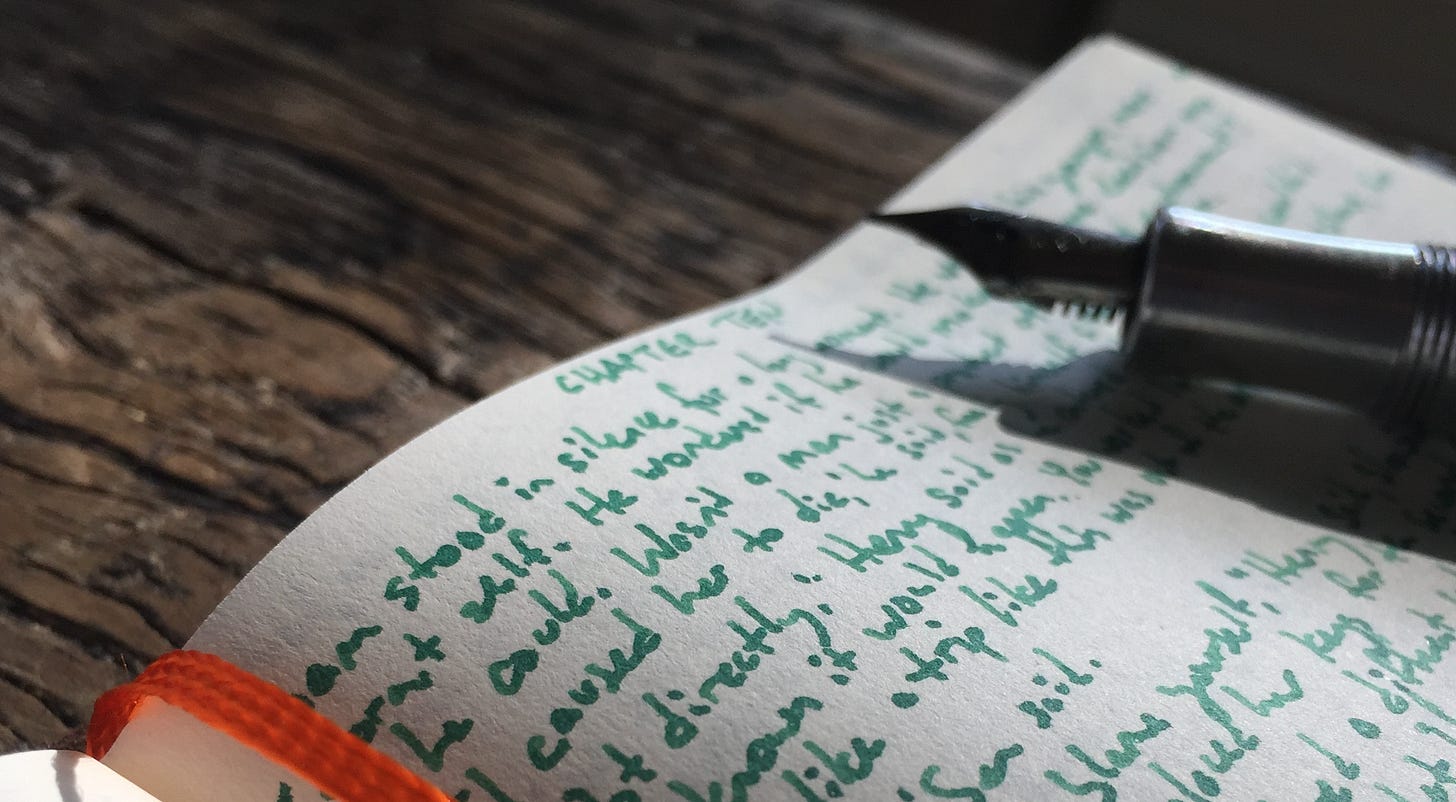Welcome to Act Two, the writing phase!
We've spent a month and a half getting on the same page and brainstorming ideas to come up with the story that only the two of you can tell together.
You might have pictures of awesome scenes dancing around in your mind and when someone asks what your story is about, you might even be able to walk them through what happens.
But we're starting with a blank page. Chapter 1, word 1.
You might be feeling the pressure to come up with some amazing opening line that will live alongside the great opening lines of literature.
My advice: don't sweat it.
Keep moving forward. This section is just for getting words down on the page (or the screen), and tell the story you have planned.
The thing that most writers hate to admit is that writing often happens in the re-writing. It's not fun or glamorous, but also you can't start fixing things until you have your first draft written... and sometimes it requires getting to know your characters to better develop them...which requires interacting with them more and more and seeing how they react.
You can always go back and fix things or adjust how you write later.
But now is the time to get the story down. And it can be so much fun! Each scene is an opportunity to surprise yourself and dive deeper into ideas and characters and locations that you never would have considered before.
So where do we start? I mean, before the opening line is written, there are a few things you'll want to figure out so you can stay consistent in how you tell your story.
Figure out: Point of View (POV), Tense, & First or Third Person.
Point of view
The Point of View character, or POV as I'll shorten it, is the character that our reader will experience this story through, for the most part. You can have one character be the POV character, or you can have multiple. In some books I've jumped back and forth each chapter between two characters to help round out the story.
Now, you need to decide if this story is being told with a Limited POV or Omniscient POV. Limited POV means that the reader can only experience what the POV character sees, smells, thinks, etc. You can't say:
Ryan sat down on the park bench with some popcorn. The ninja hiding in the bushes was hungry and decided he would steal them.
If the ninja is doing his job, then Ryan wouldn't know he was hiding in the bushes. And Ryan certainly wouldn't know that the ninja was hungry. We have to limit what we tell the reader to the things that our character is experiencing and can know.
Jumping beyond the limited POV is Omniscient POV where we're being told a story by a storyteller who knows everything and can jump around to tell whatever details they like to the reader. You can read about what one person is thinking, then jump a thousand miles away to talk about what is happening somewhere else.
Not a lot of stories can pull this off, and if this is one of your first stories, I highly recommend starting with Limited. Why?
I find it incredibly helpful to be able to look around my world and figure out how to take in everything with my senses, and then put it all into words.
The ability to communicate with others what we are seeing and what we are thinking and feeling is an incredibly valuable skill in life, and there will be some activities about how to work on that ability going forward. So, unless you have your heart set on omniscient storytelling, I really suggest you consider limiting what the reader understands through the POV character.
Plus, the more a reader can feel like they understand another character, the more we flex our empathy muscle.
Tense
Is this story being told in the present or past tense? It's a grammatical way that you are either describing everything as though it is happening right now, or you are telling the story as though it has already happened and are describing everything in past tense.
For instance:
Ryan walks over to the bench and sits down.
vs.
Ryan walked over to the bench and sat down.
I tend to prefer past tense because so much of what I read is in that tense, but sometimes new writers might accidentally switch between the two tenses in the middle of writing if they don't pick one to stick with.
First or Third Person
First person is all about me. Or I. The storyteller is the POV character in a very intimate way of telling the story.
I spotted the park bench and figured it was the best place to enjoy my popcorn.
vs.
Ryan spotted the park bench and figured it was the best place to enjoy his popcorn.
This way we refer to the POV character in third person as though the story is being told ABOUT him and not BY him.
Don't ask me why I'm on such a popcorn kick at the moment.
For those wondering, yes, there is a Second Person narrative, but it is very rarely used. In that case, the POV character is you.
You spotted the park bench and figured it was the best place to enjoy your popcorn.
Deciding if you're doing limited or omniscient, past or present, or first or third person will help you stay consistent in your writing as you tell your story.
And again, remember that you are embarking on your first draft. This should be fun, and anything you don't like, you can change later, but let's make sure you aren't spending an entire writing session trying to make that opening line the best it can possibly be.
There's always a chance you can get well into your story and later decide that it would actually be the most interesting if you ditch the first two chapters entirely and start on Chapter 3. Or that the story needs a prologue to go before Chapter 1 to better set things up.
Or you may decide your main character is interesting, but the story would be so much better if it was told from the perspective of the main character's little sister. Or the main character's teddy bear. Who knows? That's the fun of creativity.
One last thing before you start telling your story. Every writing pair might approach this differently, but figuring out who will do the drafting (or if it will be a joint effort) is something that would be wise to talk about.
When my daughter and I wrote The Invisible House, we would walk and talk through the brainstorming of what would happen in each chapter. Then we would together figure out the outline.
Then when we started drafting, I started writing the sentences while saying them out loud...and I lost her attention (she was 6 at the time).
So I took the outline we had created together and drafted the words for one chapter. Then I would read them aloud to her before bedtime and make sure I didn't use any words that weren't on her reading level and made notes on any points that created confusion. Then I took all feedback from her and went back and made sure I added those quick fixes.
We'd repeat the process for chapter 2 the next day.
Now that she's almost twice that age, our collaboration works a little bit differently, and there are some stories she writes all on her own that I read and give feedback on.
There's no wrong way to do it if the two of you are collaborating and creating a story together. Well, there's one wrong way, and I'll go more into that at another time, but it involves letting something else do all of the writing for you, which kind of defeats the purpose of this.
All right, hopefully once you've gotten this figured out, you'll be able to take your outline and start out your character on their journey!














Share this post